

The Eternal Flame (1922) Norma Talmadge Film Company/First National. Produced by Joseph M. Schenck. Directed by Frank Lloyd. Adapted by Frances Marion. Photography by Tony Gaudio. Art direction by Stephen Goosson. Costumes by Walter J. Israel. Cast: Norma Talmadge, Adolphe Menjou, Wedgewood Nowell, Conway Tearle, Rosemary Theby, Kate Lester, Thomas Ricketts, Otis Harlan, Irving Cummings. 8 reels. The Library of Congress has a copy of reels 1-2, and 4-7 (35 mm.)
 |
Norma pleads with the implacable Conway Tearle. They faced off again in Ashes of Vengeance, but Norma got the better of him in She Loves and Lies. He was leading man to many of Hollywood's top stars, even though he often seemed to be more grim adversary than lover. Clara Kimball Young speaks highly of him in her article on screen lovers. | |
| A sheet music cover (thanks to Derek Boothroyd for this and the next bunch) | 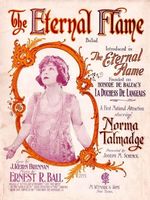 |
|
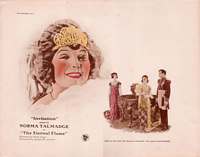 |
An unusual lobby card for the film | |
| A film still | 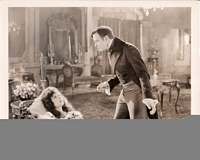 |
|
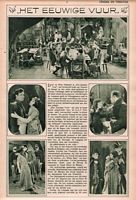 |
A nice Dutch booklet from the film | 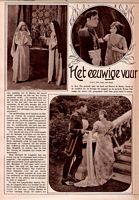 |
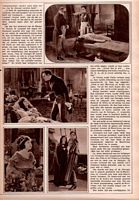 |
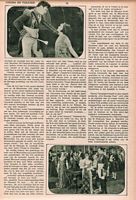 |
See also a still photo from the J. Willis Sayre photograph collection at the University of Washington.
Norma Talmadge feature, adapted from Balzac's novel, "Duchesse de Langeais," by Francis Marion. Directed by Frank Lloyd. Distributed by First National. At the New York Strand, Sept. 17
| Duchesse de Langeais | Norma Talmadge |
| Duc de Langeais | Adolphe Jean Menjou |
| Marquis de Ronquerolles | Wedgewood Nowell |
| General de Montriveau | Conway Tearle |
| Madame de Serizy | Rosemary Theby |
| Princesse de Vlamont-Chaurray | Kate Lester |
| Vidame de Pamier | Thomas Ricketts |
| Count de Marsay | Irving Cummings |
| Abbe Conrand | Otis Harlan |
The picture, which deals with the locale of Paris in Napoleon's day, is done on a scale of magnificence exceptional even for this star. Its costuming, settings and massed people in several scenes mark it as a costly production. The picture has notable beauty and pictorial force, but is almost lacking in strong drama.
The nature of the story makes it so. It is mostly a succession of close-ups of Miss Talmadge and Conway Tearle as the centers of emotional scenes marking the progress of the distinctly sentimental story. It might have better been called "The Conquest of a Coquette," for that is the real basis of the tale, for the gradual surrender to love of an embittered woman, told in the keenly analytical fashion of the great Frenchman.
It's all interesting, but it hasn't the grip of drama, particularly as it comes on the screen in pantomime. That passage where Montriveau abducts the Duchesse and threatens to brand her as his own has melodramatic values, but that is the only spot where the picture reaches dramatic force. Its final scenes have extraordinary emotional power, however, and it probably will be on the strength of the appeal here that the picture will create talk. It is here that the Duchesse having been cast aside by Montriveau and having sought asylum in a convent, surrenders to the need of the spiritually broken man and returns to the world she had abandoned in order to restore him--the protective instinct of the maternal triumphant.
These scenes in the convent with their austere background and the striking lighting effects give the picture immense effect. Another smash in a pictorial sense is the passage of the grand ball, a whale of a spectacle, with apparently hundreds of dancers in the stunning costumes of the period in graceful ballroom maneuvers. The direction is always effective in a well-balanced way. The illusion of real life is splendidly maintained in spite of the artificiality of the surroundings, a result of both the directing intelligence and the fine acting sense of the players. Miss Talmadge brings great judgement to the aid of her special type of beauty and he eloquent face, and Mr. Tearle, one of the least actor-like of screen actors, achieves a real creation as the moody, woman-hating general.
One thing the adapter has been especially successful in achieving is a deft concentration of interest in the principal characters. Although nine roles are of sufficient importance to require listing in the cast, the attention is never diffused. It centers upon the two vital personages, which stand out clean cut as cameos. Miss Talmadge, as always, exhibits a ravishing assortment of frocks,--an important production feature where this star is concerned. In other respects the production achieves innumerable excellences. The settings are an independent feature of the picture. Astonishing effects of space are secured in the interiors, which have an atmosphere of authentic reproductions. The ballroom scene must have represented a considerable investment. But all this magnificence merges into the ensemble unostentatiously, not as a revel in picture cost, but as an appropriate background for a colorful story.
The picture will probably be voted a little "fine" by the generality of fans, lacking somewhat in what is popularly called action, but pretty and "sweet."
Balzac and Norma Talmadge.
Some of Norma Talmadge's later pictures have been regrettably feeble attempts, but she does much to atone for them in "The Eternal Flame," which is at the Strand this week.
It is unquestionably a fine picture, because it presents the always competent Miss Talmadge with an excellent story, intelligent direction and an unusually good supporting cast. The scenario, by Marion Fairfax [i.e. Francis Marion], is an adaptation of Balzac's novel, "La Duchesse de Langeais," and while Miss Fairfax has translated rather freely from the original French, one is compelled to concede that she was justified in doing so. The earlier reels of the picture are littered up with epigrammatic sub-titles, which are somewhat more reminiscent of The Smart Set than of Balzac, but this is fortunately only a passing phase. After Miss Fairfax has exhausted the world's supply of machine-made witticisms, the language of the sub-titles comes down to normal.
Norma Talmadge is admirably suited to the role of the Duchesse de Langeais, whose indiscriminate flirtations set Paris by its Gallic ears. She displays all the roguish irresponsibility which is generally associated with her sister, Constance, and also that genuine intensity which is particularly her own. She receives stalwart assistance from the serious Conway Tearle, whose reproving frown is much in evidence.
"The Eternal Flame" is a costume drama, and therefore the margin of possible error is greater than it would be in a modern setting. But the scenes and the costumes are authentic and the eighteenth century Parisian atmosphere has been faithfully reproduced. The director, Frank Lloyd, is probably responsible for this. He has made a careful, workmanlike job of the whole picture, without any undue straining for effects.
Director Joseph Plunkett of the Strand has arranged an effective musical accompaniment for the film.
"The Eternal Flame"
Splendid First National Production That Will Make More Norma Talmadge Enthusiasts
Reviewed by Roger Ferri
If you have a "lemon" house on your hands and want to turn it into a gold mine, don't overlook Norma Talmadge's masterpiece production, "The Eternal Flame." It is first an artistic picture and then an entertainment vehicle that will live for a long, long time. Personally, this writer believes it to be the greatest picture ever made by this charming star, who in this particular instance gives as fine a piece of character acting as witnessed in any picture. But the wonderful and outstanding feature is that every thing is perfect, acting, direction, lighting, photography and settings. It is flawless, with every player doing his or her share, with the result that with a little good showmanship "The Eternal Flame" should leave in its wake a long string of broken box office receipts.
For some reason, best known to the producers, this picture is being compared with "Smilin' Through." It is not as sentimental as that Talmadge success, but it is a greater, bigger, and even finer production. "Smilin' Through" made them weep; "The Eternal Flame" will send them out of the theatre boosting. There is nothing left undone an no opportunity in Honore de Balzac's famous novel, "La Duchesse de Langeais," has been overlooked.
In the role of the Duchess, Miss Talmadge furnishes a splendid study, full of human interest and realistic to the point where one is so impressed that he feels he would like to take this faithful wife by the hand in congratulation for all that she does. But it is as the merciless coquette wherein Miss Talmadge scores her greatest triumph. She wears gorgeous costumes of the French court beautifully, and, all in all, the picture she presents is charming to look at. Conway Tearle as General De Mortiveau could not have given a better characterization without ruining the interesting role of the persistent lover who finally subdues the reigning beauty of France. Others who do meritorious work worthy of commendation are Rosemary Theby, Otis Harlan, Irving Cummings, Adolphe Jean Menjou, Thomas Ricketts and Wedgewood Nowell.
The direction of Frank Lloyd is superlative in every particular, while the settings, laid in the period when Louis XVIII ruled supreme, are gorgeously picturesque and historically correct, the elaborate ball scenes being one of the finest of its kind ever flashed on the silver sheet. The lighting was all that it should be.
Briefly, "The Eternal Flame" is a costume play that is different from the rest. It has melodramatic value plus a romance that grips you from start to finish and a cast of names that is a business-getter.
The Cast:
| Duchesse de Langeais | Norma Talmadge |
| Duc de Langeais | Adolphe Jean Menjou |
| General de Montriveau | Conway Tearle |
| Madame de Serizy | Rosemary Theby |
| Princesse de Vlamont-Chaurray | Kate Lester |
| Vidame de Pamier | Thomas Ricketts |
| Count de Marsay | Irving Cummings |
| Abbe Conrand | Otis Harlan |
| Marquis de Ronquerolles | Wedgewood Nowell |
Presented by Joseph F. [sic] Schenck
Directed and Supervised by Frank Lloyd
Adapted by Frances Marion from Honore de Balzac's "La Duchesse de Langeais"
Length, 7,453 feet
The Story
Duchesse de Langeais, a charming beauty, is married to a severe French army officer. She hears of a bet he has made with other officers, relative to her faithfulness. This knowledge completely turns the heretofore loyal wife into a cynically heartless coquette, who breaks heart after heart in the court of Louis XVIII. Finally she falls in love with General De Mortriveau, who kidnaps her and threatens to brand her. He relents, however, seeking forgetfulness, and refusing to answer notes or to see her. She, repentant, enters a convent, hidden away for years. Meanwhile, the General has found it impossible to forget and he seeks her, finally locating her in the convent and succeeding in procuring her release
Reel three and eight (the last reel) are missing from the only existing copy of this film in the Library of Congress, so the Variety reviewer's comments on the convent scene concern a segment now lost. His characterization of a film in which the leading man threatens the leading lady with a hot branding iron as "sweet" seems an odd choice of words.
This is one of those extravagantly masochistic women's films. Though the titles tell us Talmadge is a cruel heartbreaker, she never seems very bad. The only man we see labeled as her "victim" is a kind elderly man who is her closest friend and confidant. She makes a wager that she can make a notorious woman-hater fall in love with her. Unfortunately she sets her sights on an extraordinarily self-righteous and sadistic man, who is so enraged at her deception that he kidnaps her and tries to brand her forehead with a hot iron, egged on by a curious shadow character who tells him that women like her love to be treated cruelly. He ultimately lets her go, but despite this, she still tries to continue the relationship, writing to him every day while sinking into despair and then resignation as he ignores her. At her final letter, his "shadow" finally decides that she has suffered enough, but when they go to her she had disappeared. In the missing final reel, he finds her in a Spanish convent just before she is to take final vows and they are reconciled, though it is not clear from the surviving synopses what became of her husband. The film is very well done, beautifully photographed and acted, but the characters are rather sick.
Print viewed: 35mm from the Library of Congress, missing reels 3 and 8.
Last revised, October 12, 2010